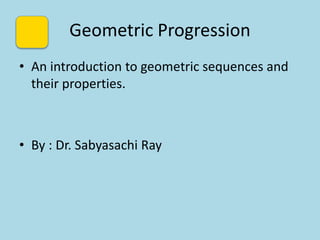Geometric_Progression_Presentation_Colorful.pptx
- 1. Geometric Progression • An introduction to geometric sequences and their properties. • By : Dr. Sabyasachi Ray
- 2. General Form • A geometric progression (GP) is a sequence of numbers where each term after the first is found by multiplying the previous term by a constant. The general form of a GP is: • a, ar, ar2, ar3, ...
- 3. Common Ratio • The constant factor between consecutive terms is called the common ratio (r). If the first term is a, then the second term is ar, the third term is ar2, and so on.
- 4. Finding the n-th Term • The n-th term (Tn) of a geometric progression can be found using the formula: • Tn = a * r(n-1) • where a is the first term, r is the common ratio, and n is the term number.
- 5. Sum of the First n Terms • The sum of the first n terms (Sn) of a geometric progression is given by: • - For r ≠1: Sn = a * (1 - rn) / (1 - r) • - For r = 1: Sn = a * n
- 6. Applications of Geometric Progressions • Geometric progressions are used in various fields such as finance (compound interest), biology (population growth), physics (radioactive decay), and computer science (algorithm analysis).
- 7. Examples • 1. Find the 5th term of a GP with a = 2 and r = 3.
- 8. Examples • 2. Calculate the sum of the first 4 terms of a GP with a = 5 and r = 2.
- 9. Example 1 • Find the 5th term of a GP where the first term (a) is 2 and the common ratio (r) is 3. • Solution: • Tn = a * r^(n-1) • T5 = 2 * 3^(5-1) • T5 = 2 * 3^4 • T5 = 2 * 81 • T5 = 162
- 10. Example 2 • Calculate the sum of the first 4 terms of a GP where the first term (a) is 5 and the common ratio (r) is 2. • Solution: • Sn = a * (1 - r^n) / (1 - r) • S4 = 5 * (1 - 2^4) / (1 - 2) • S4 = 5 * (1 - 16) / -1 • S4 = 5 * (-15) / -1 • S4 = 75
- 11. Example 3 • If the 3rd term of a GP is 16 and the 6th term is 128, find the common ratio and the first term. • Solution: • T3 = ar^2 = 16 • T6 = ar^5 = 128 • Divide T6 by T3: • (ar^5) / (ar^2) = 128 / 16 • r^3 = 8 • r = 2 • Substitute r into T3: • a * 2^2 = 16 • a * 4 = 16 • a = 4 • First term (a) = 4 • Common ratio (r) = 2
- 12. Example 4 • The sum of the first 5 terms of a GP is 31 and the first term is 1. Find the common ratio. • Solution: • S5 = a * (1 - r^5) / (1 - r) • 31 = 1 * (1 - r^5) / (1 - r) • 31 = (1 - r^5) / (1 - r) • 31 * (1 - r) = 1 - r^5 • 31 - 31r = 1 - r^5 • r^5 - 31r + 30 = 0 • Solve for r (possible values by trial and error or factoring): • r = 2 (valid solution)












